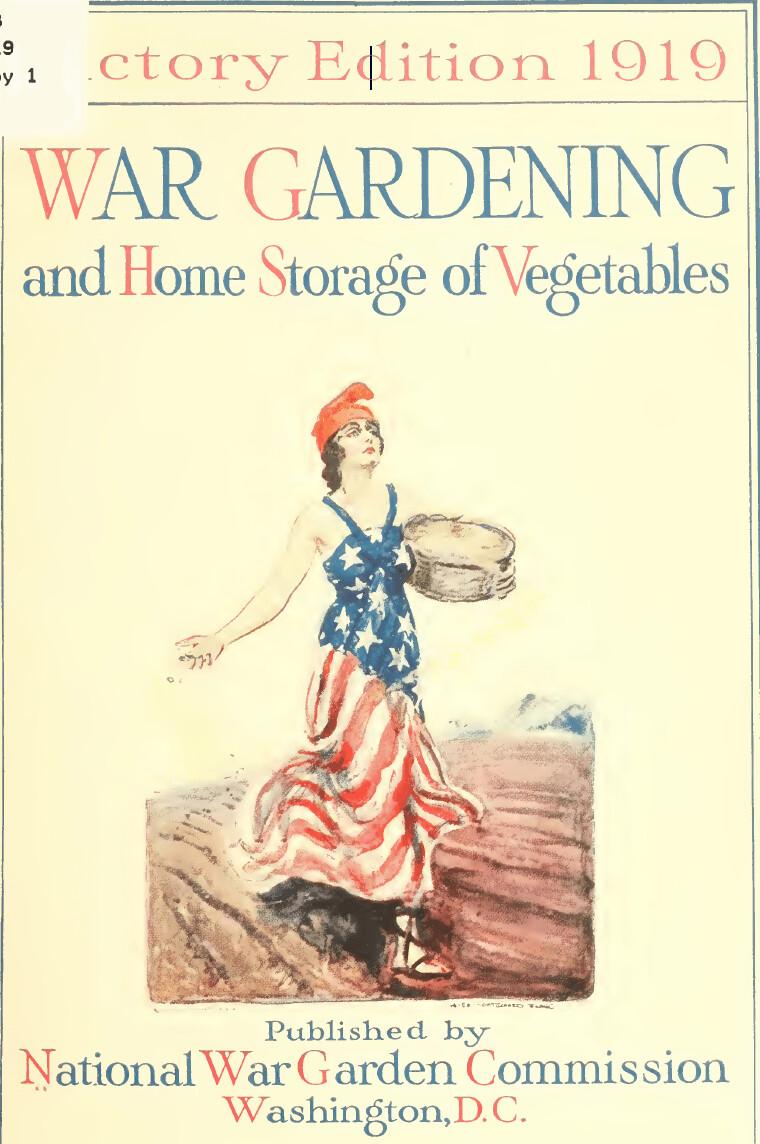$2 Download. War Gardening & Home Storage of Vegetables Victory Edition 1919 – 38p
Victory Gardening
MAKE YOUR WAR GARDEN
A GARDEN OF VICTORY
By CHARLES LATHROP PACK, President
National War Garden Commission
AMERICA'S
responsibility for
the world's food supply did
L not stop with the ending
of the war. In peace, as in conflict,
this country must carry the burden
of Europe's food problems. With
the advent of peace these problems
have become intensified. America is
now expected to furnish the solution
and this can be done only through
the continued application of high
pressure food production and unwavering
food conservation.
For two years of war the War
Gardens of America produced foodstuffs
which helped establish the
balance of power between starvation
and abundance. In the spring of
1918, General Haig declared, "We
stand with our backs to the wall."
Of that call to the civilized world no
phase was more vital than its interpretation
and answer in terms of
food. During that year the answer
was given by the American people
with true American spirit. The war
gardeners of the United States responded
with a vigor which carried
the War Gardens over the top to
victory. By the addition of more
than five hundred million dollars of
crop value to this country's food
production they made it easier for
America to feed het own people and
the people of France and Belgium.
The Victory Garden is now as
vital as the War Garden. Peace
brings new food needs. In reclaiming
territory from the enemy France
and Belgium have greatly increased
the number of their people who must
be fed. By restoring these former
expatriates to citizenship these countries
have also assumed the burden
of feeding them. This will mean a
vast increase in the demands on
America as the source of Europe's
food supply in. 1919. Europe cannot
feed herself during the first year
of reconstruction; Russia faced famine
conditions in the winter of 19 18-
1919, and Mr. Hoover says that the
world's food shortage will last for
another seven years.
The war gardener's responsibility,
therefore, did not end with the coming
of peace. His War Garden must
now be made a Victory Garden in
the full sense of the words. It must
help solve the problem of feeding
people rendered helpless by years
of ruthless and terrible vvar.
The garden crop of 19 19 must be
even greater than that of 191 8, and
there must be more canning and dry ing
for winter use. The people of
America have a real duty to perform
in this respect and the nation counts
confidently on full measure of individual
response.
PART I
WAR GARDENING MANUAL
As a result of emergency created by war the home garden of America has
become an institution of world-wide importance. The planting and growing
season of 1918 demonstrated that the products thus raised are essential to the
feeding of the people of the United States and'the Allied Nations, Under the
impetus given by the National War Garden Commission the people of this
country last year produced a crop valued at $520,000,000 in gardens cultivated
in backyards, on vacant lots and on other land previously untilled — the
patriotic gift of the war gardens to the nation.
'Peace can in no wise diminish America's responsibility for feeding
Europe. The recovery of vast areas of devastated country in France and
Belgium greatly increases the number of people to be fed and adds heavily
to the food burden of America. Because of this the Victory Garden is no
less necessary than the War Garden.
WAR GARDENS HELP SOLVE TRAFFIC PROBLEM
War-time brought the most serious traffic
congestion the United States has ever seen.
This condition has no meaning more significant
than that the gardens of this year must
do even more than those of 1918 in freeing the
overburdened railroads from the need for
transporting food products. ÄÄ'ith food short age
threatening the Allied Nations and with
railroad congestion as an added factor, the
war garden results of the coming season must
be considerably greater even than the vast
yield of last year.
COMMUNITY GARDENING
Excellent results are obtained through co operative
gardening work. If several fami lies
join forces they can reduce the cost of
gardening in time, labor and money. Fami lies
having adjoining or neighboring garden
plots may use one set of tools. To prevent
clash of convenience it is well to have an
understanding in advance as to the time
when each gardener is to have the use of
particular tools. By this arrangement it is
possible to have complete equipment at expense
much less than if each gardener bought
his own. Money can also be saved in buying
seeds, fertilizers and spraying materials by
clubbing together and gaining advantage of
the lower prices for large lots.
One of the advantages of doing community
work is that it is possible for the gar deners
interested in the project to employ a
man and a team to prepare their gardens by
plowing and harrowing. In this way the
man and team can be kept busy throughout
the day and the expense to each gardener
will be slight.
On a larger scale this principle should be
applied to garden plots on tracts of vacant
land allotted to individuals in or near cities
or towns. Each plot in such a tract is a
separate garden, belonging to the individual
or family to whom allotted. In many in stances
the municipal authorities, the mayor's
war garden committee or some similar local
organization, will provide an expert to supervise
work on community gardens of this
character. This expert will give advice and
instructions as to preparation, planting and
cultivation and on other technical subjects.
If an expert is not provided in this way it
is wise for the gardeners to club together and
arrange for one at their own expense, if the
project is large enough to make this possible
without too great individual cost. The help
of an expert is of great value.
School children and parents may work to gether
to good advantage on these garden
plots. In some communities school authorities
allow the children to spend a portion
of the school hours, on stated days, in
their garden work. Through co-operation
with street cleaning departments a municipal
government may arrange to deliver
manure to war gardeners at nominal cost.
In at least one important city this is done at
a charge of $2 per load.
It is a good plan for municipal govern ments
to arrange for lectures at school
houses or other places on practical problems
in gardening. This increases efficiency.
CORPORATION GARDENS
Manufacturing concerns, and other enter prises
which employ labor on a large scale,
may make valuable contribution to the
national food supply by encouraging their
employees to cultivate war gardens. Many
concerns furnish large tracts of land, which
are divided into individual garden plots.
These plots are allotted to such employes as
are willing to cultivate them. Each plot and
everything it produces are recognized as the
individual property of its cultivator. The
company bears the expense of plowing and
fertilizing these plots and emj^loys an expert
to have charge.
HOW TO HAVE A GOOD GARDEN
Garden Plan
Have a plan for your garden — drawn to
scale on paper — before you start, to give
proper order in planting and enable you to
buy the right amount of seeds in adviince
while the selection is good.
Put in one general group small plants like
beets, onions, lettuce, carrots, radishes and
parsnips. In another general group put
larger plants like corn, tomatoes and pota toes.
Spreading ground vines, like melons
and cucumbers, which need wider spacing,
should be put in another general group. The
reason for this grouping is that the various
plants in a group need similar general treatment
as well as spacing.
In making a plan provide space in which
to enter costs and yield of the various crops.
This will give you a complete record w^hich
will be useful another year. Another helpful
use of the plan is that it will guide you in
the rotation of next year's crops. For this
purpose save your plan for next season.
In planning your garden formulate some
definite plan as to what you will do with
surplus vegetables. Detailed instructions for
home storage of vegetables for winter use are
given in Part II of this booklet. Detailed
instructions for canning, drying, pickling and
other forms of conservation are given in the
Home Manual on these subjects issued by
this Commission.
Sunshine
In the location of a garden it is not always
possible to choose conditions as to sunlight.
It is important, therefore, that in the arrangement
of the various varieties of vege tables
which are to be planted, due care
should be given to providing the greatest
exposure to the sun for those crops which
need it most. Those plants which must ripen
their fruits, such as tomatoes and eggplant,
require the greatest amount of sunshine,
while lettuce, spinach, kale and other leaf
crops require relatively less. Foliage crops
must have at least 3 hours of sunlight a day
and plants which ripen fruits at least 5 hours
a day. This is important.
Vary from Last Year's Plan
It is important to remember that plant
diseases and insects are apt to thrive in a
spot in which they have become established.
For this reason those who make gardens
this year should take care not to place the
individual crops in the spot in which the
same crops grew last year. Varying the arrangement
of the garden in this way will reduce
the danger from disease and insects. The
same vegetables in the same place each year
exhaust certain food elements, and reduced
yields are sure to result.
SURPLUS PRODUCTS
At times, even with the best of planning,
a gardener will find that his garden has
matured more of some varieties of vegetables
than can be used immediately. None of this
excess should be wasted and there is no
occasion for waste. If there is no ready
market for the surplus it should be prepared
for winter by either canning or drying. By
modern methods either canning or drying
may be done with little expense of time,
trouble or financial outlay. By using the
THE SEEDS OF VICTORY INSURE THE FRUITS OF PEACE
cold-pack method as small a quantity as a
single can or jar may be put up in a short
time. With proper instructions it is possible
for the housewife to dry a handful of peas or
beans, sweet corn, a few sweet potatoes or
turnips, or small quantities of many other
vegetables with practically no expenditure of
her time. Explicit and simple directions for
canning and drying are given in the Manual
issued by the National War Garden Commission.
THE SOIL AND MANURES
The back yard ga.dener must use the soil
he has, but he can improve it if is poor, and
he must do this as far as possible. Stable
manure will help even the
richest soil, and you are
not likely to use too much
of it. During a single season
professional gardeners apply
as much as six inches of it.
From 400 to 600 pounds can
be used to advantage on a
plot 20 by 20 feet. Coarse
manure should be applied
and thoroughly plowed or
spaded under in the fall.
In the spring, fine, rotted F'S- 2 — This shows the construction of an outdoor cold frame. A hotbed is
manure is ]■ 1 • , built in the sameway, except that for the hotbed a pit and manure are required. ^ appiiea, just See page 7 for directions for making cold frames and hotbeds.
before plowing or spading,
preceding the planting of any crop.
containing 3 to 4 per cent nitrogen and 8 to 10
per cent phosphoric acid is about right for the
average garden. Your dealer will inform
you on this point. If the fertilizer also contains
potash, so much the better, but this year
potash is scarce and high in price.
Where no manure is used the fertilizer
should be spread over the surface of the finely
prepared seed-bed at the rate of 5 pounds
for a plot 10 feet square, just before planting.
The surface soil should then be thoroughly
raked so as to mix the fertilizer evenly to a
depth of 2 inches. Never place seed or transplanted
plants in direct contact with fertilizer.
Thorough mixing of the fertilizer with the soil
is essential to prevent injury of seed or roots.
If the
ground is fairly rich, and well-rotted manure
is scarce, the manure may be scattered in the
row only, and should be mixed into the soil
before the planting of seed.
Loam is the best garden soil. Sand, with
manure, gives good results. Clay is hardest
to work, but is greatly improved by wellrotted
manure and vegetable matter — called
humus. These should be well worked in
with hoe and rake. Sifted coal ashes, en tirely
free from clinkers, will help loosen up
clay when mixed into
it,
but will not remove
an acid condition nor increase fertility.
Where manure has been worked into the
soil, reduce the fertilizer application approximately
one-half.
Tomatoes, eggplants, potatoes, spinach and
some other crops requiring rather long growing
seasons, are materially benefited by a second
application of fertilizer when half grown.
Side dressings of this kind should be scattered
between the rows at the rate of four ounces
(one-half pint) to 10 feet of row, when rows
are spaced
2
feet apart; and pro rata for rows .
spaced
a
greater or lesser distance. To insure
even distribution mix the fertilizer with fine,
dry earth just before spreading.
Commercial Fertilizer
Many gardeners experience difficulty in
obtaining supplies of well-rotted manure.
In such cases commercial fertilizers should
be used. Even where stable manure has
been secured and worked into the soil
it
is
well to supplement with moderate quantities
of quick-acting fertilizer in order to give
plants an early start and hasten maturity.
It
is
safest to rely upon the ready-mixed
fertilizers usually obtainable at seed and
hardware stores. Several specially prepared
mixtures in convenient packages are now on
the market. For large areas, 100 to 200-
pound bags may be obtained. A mixture
Compost
Compost
is
especially desirable when
quick growth
is
wanted. Compost
is
thoroughly
rotted manure or organic material.
It
is
prepared from six to twelve months
before being used, by putting the manure
and other material in piles having perpen dicular
sides and flat tops. These piles
are usually from
2
to
4
feet high and
6
to
8
feet long.
Besides the usual waste of garden rubbish,
there
is
a large waste of leaves, weeds and
the skins and other unused portions of fruits
and vegetables. These should all be thrown
on the compost pile to decay for use on the
Website & Reports published by Youra Media – Seattle Washington
© Youra Media 2023





